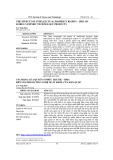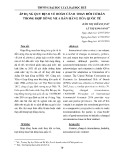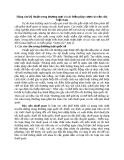
TẠP CHÍ KHOA HỌC - ĐẠI HỌC ĐỒNG NAI, SỐ 31 - 2024 ISSN 2354-1482
37
THE IMPACT OF THE EUROPEAN UNION–VIETNAM FREE
TRADE AGREEMENT AND THE EUROPEAN GREEN DEAL
ON VIETNAMESE EXPORTS
Lam Dang Xuan Hoa
Ho Chi Minh City University of Economics and Finance
Email: hoaldx@uef.edu.vn
(Received: 03/6/2024, Revised: 20/6/2024, Accepted for publication: 21/6/2024)
ABSTRACT
In this study, the researcher focuses on exploring the impact of the European
Union–Vietnam Free Trade Agreement and the European Green Deal on Vietnamese
exports. This article used qualitative methods, including collecting and analyzing
secondary data. The objective is to understand the requirements and standards set by
the European market and the advantages that the free trade agreement impacts on
the quality and competitiveness of Vietnamese export products. This study is
interested in evaluating the potential for improving product quality and enhancing
competitiveness in Vietnam's export industry to take advantage of the free trade
agreement and also to meet the requirements of the European Green Deal. In
addition, the article will also analyze the challenges that Vietnamese export
businesses must handle. Beside that, this research also provides policy guidelines
and strategic decisions to enhance Vietnam's export capabilities to the European
market.
Keywords: European green deal (EGD), European Union–Vietnam Free Trade
Agreement (EVFTA), Vietnamese export
1. Introduction
The signing and implementation of
the European Union–Vietnam Free
Trade Agreement (EVFTA) and the
European Green Deal (EGD) marks a
significant milestone for Vietnamese
exports when attacking the European
market. These agreements, aimed at
fostering economic cooperation and
sustainable development, hold immense
importance for Vietnam, the EU, and
the global economic landscape.
This article aims to provide a
comprehensive overview and analysis
of the EVFTA and the EGD, exploring
their implications, challenges, and
opportunities for both Vietnam and the
EU. By examining the provisions,
impacts, and potential outcomes of
these agreements, this article aims to
shed light on their significance and
urgency in the current geopolitical and
economic context.
In the following sections, we will
delve into the key components of the
EVFTA and the EGD, discussing their
implications for various sectors
including trade, investment,
environment, and social development.
Additionally, we will analyze the
potential challenges and opportunities
arising from the implementation of
these agreements, as well as their
broader implications for global trade
and sustainable development.
Overall, this article seeks to
contribute to a better understanding of the
EVFTA and the EGD, providing valuable
insights for policymakers, businesses, and

TẠP CHÍ KHOA HỌC - ĐẠI HỌC ĐỒNG NAI, SỐ 31 - 2024 ISSN 2354-1482
38
stakeholders involved in shaping the
future of economic cooperation and
sustainable development between
Vietnam and the EU.
2. Theoretical background
2.1. European Green Deal
According to Communication from
the Commission to the European
Parliament, the European Council, the
Council, the European Economic and
Social Committee and the Committee of
the Regions (European Commission,
2019), this Communication sets out a
European Green Deal for the European
Union (EU) and its citizens. It resets the
Commission’s commitment to tackling
climate and environmental-related
challenges that is this generation’s
defining task. The atmosphere is
warming and the climate is changing
with each passing year. One million of
the eight million species on the planet
are at risk of being lost. Forests and
oceans are being polluted and
destroyed.
The European Green Deal is a
response to these challenges. It is a new
growth strategy that aims to transform
the EU into a fair and prosperous
society, with a modern, resource-
efficient and competitive economy
where there are no net emissions of
greenhouse gasses in 2050 and where
economic growth is decoupled from
resource use.
The environmental ambition of the
Green Deal will not be achieved by
Europe acting alone. The drivers of
climate change and biodiversity loss are
global and are not limited by national
borders. The EU can use its influence,
expertise and financial resources to
mobilize its neighbors and partners to
join it on a sustainable path. The EU
will continue to lead international
efforts and wants to build alliances with
the like minded. It also recognises the
need to maintain its security of supply
and competitiveness even when others
are unwilling to act.
Figure 1: The European Green Deal (Source: European Commission, 2019)

TẠP CHÍ KHOA HỌC - ĐẠI HỌC ĐỒNG NAI, SỐ 31 - 2024 ISSN 2354-1482
39
Table 1: Description of the European Green Deal fields activities and scope
European
Green Deal
fields
Describing EGD fields
Increasing the
EU’s climate
ambition for
2030 and
2050
Between 1990 and 2018, the EU reduced greenhouse gas
emissions by 23%, while the economy grew by 61%.
However, current policies will only reduce greenhouse gas
emissions by 60% by 2050. By 2020, the Commission plans
to increase the EU’s greenhouse gas emission reduction target
for 2030 to at least 50% and towards 55% compared with
1990 levels in a responsible way. The Commission proposes a
carbon border adjustment mechanism, for selected sectors, to
reduce the risk of carbon leakage. This would ensure that the
price of imports reflects more accurately their carbon content
Supplying
clean,
affordable
and secure
energy
Transitioning to clean and renewable energy sources such as
solar, wind, hydro, and bioenergy is a cornerstone of the
European Green Deal. Setting ambitious targets to achieve
climate neutrality by 2050, the deal aims to reduce carbon
emissions in the energy sector significantly. The goal is to
achieve "net-zero greenhouse gas emissions" by 2050,
promoting energy efficiency and investing in research and
development of clean energy technologies to drive this
transition forward.
Mobilizing
industry for a
clean and
circular
economy
Implementing policies for a circular economy lies at the heart
of the sustainable industry aspect of the European Green
Deal. This involves reducing waste and promoting the reuse
and recycling of materials across various sectors. The deal
also emphasizes reducing carbon emissions and increasing
energy efficiency in energy-intensive industries like steel and
cement. Furthermore, it supports innovation and the adoption
of sustainable practices in industrial processes, along with
investing in clean technologies to foster collaboration
between industry stakeholders.
Building and
renovating in
an energy and
resource
efficient way
Promoting energy-efficient building practices and renovating
existing structures to improve energy performance and reduce
emissions are key objectives of the European Green Deal's
building and renovation component. This includes advocating
for the use of sustainable materials and technologies in
construction projects and setting standards to ensure that new
buildings meet high energy efficiency and sustainability
criteria. Additionally, the deal offers incentives and support
for building owners to invest in energy-saving renovations,
contributing to overall energy conservation efforts.
A zero-
pollution
The European Green Deal sets ambitious goals to eliminate
pollution from all sources, including air, water, and soil. This

TẠP CHÍ KHOA HỌC - ĐẠI HỌC ĐỒNG NAI, SỐ 31 - 2024 ISSN 2354-1482
40
European
Green Deal
fields
Describing EGD fields
ambition for a
toxic-free
environment
toxic-free
environment
involves implementing strict environmental standards and
regulations to limit emissions and pollutants across various
sectors. Furthermore, the deal emphasizes investing in
pollution control technologies and infrastructure upgrades to
reduce environmental contamination. Additionally, efforts are
made to promote pollution prevention and resource efficiency
in industrial processes and activities to mitigate the impact on
ecosystems and public health.
Preserving
and restoring
ecosystems
and
biodiversity
Protecting and restoring biodiversity is a crucial goal of the
European Green Deal, encompassing measures such as
reforestation, habitat conservation, and wildlife management.
This involves promoting sustainable land use practices that
preserve natural ecosystems and minimize habitat destruction.
Furthermore, the deal supports efforts to combat biodiversity
loss and address the impacts of climate change on ecosystems
through international cooperation and collaboration.
Additionally, fostering awareness and understanding of
biodiversity conservation among the public is essential for
achieving long-term sustainability goals.
From Farm to
Fork
Focusing on supporting sustainable agriculture practices that
minimize environmental impact and promote biodiversity.
This involves reducing the use of pesticides and antibiotics in
agriculture to protect both human health and the environment.
Additionally, efforts are made to encourage healthy and
sustainable food choices among consumers through education
and awareness campaigns. Furthermore, the deal promotes the
adoption of sustainable farming techniques such as organic
farming and agroecology to ensure the long-term
sustainability of food production.
(Source: author’s work based on Communication…, 2019)
Especially from 2023, the EU
began piloting new regulations. This
poses a significant challenge due to
mandatory standard requirements and
huge costs. Some new regulations of the
EGD:
• CBAM: The EU’s Carbon
Border Adjustment Mechanism
(CBAM) is the EU's tool to put a fair
price on the carbon emitted during the
production of carbon intensive goods
that are entering the EU, and to
encourage cleaner industrial production
in non-EU countries. By confirming
that a price has been paid for the
embedded carbon emissions enerated in
the production of certain goods
imported into the EU, the CBAM will
ensure the carbon price of imports is
equivalent to the carbon price of
domestic production, and that the EU's
climate objectives are not undermined.

TẠP CHÍ KHOA HỌC - ĐẠI HỌC ĐỒNG NAI, SỐ 31 - 2024 ISSN 2354-1482
41
The CBAM is designed to be
compatible with WTO-rules. CBAM
will apply in its definitive regime from
2026, while the current transitional
phase lasts between 2023 and 2026.
This gradual introduction of the CBAM
is aligned with the phase-out of the
allocation of free allowances under the
EU Emissions Trading System (ETS) to
support the decarbonisation of EU
industry.
• The Regulation on
deforestation-free products: on 29 June
2023, the Regulation on deforestation-
free products entered into force. The
main driver of these processes is the
expansion of agricultural land that is
linked to the production of commodities
like cattle, wood, cocoa, soy, palm oil,
coffee, rubber, and some of their
derived products, such as leather,
chocolate, tires, or furniture. As a major
economy and consumer of these
commodities linked to deforestation and
forest degradation, the EU is partly
responsible for this problem and it
wants to lead the way to solving it.
Under the Regulation, any operator or
trader who places these commodities on
the EU market, or exports from it, must
be able to prove that the products do not
originate from recently deforested land
or have contributed to forest
degradation.
2.2. European-Vietnam Free Trade
Agreement (EVFTA)
According to European
Commission, the European Union and
Vietnam signed a Trade Agreement and
an Investment Protection Agreement on
30 June 2019. The agreements provide
opportunities to increase trade and
support jobs and growth on both sides
by:
Eliminating 99% of all tariffs;
Reducing regulatory barriers and
overlapping red tape;
Ensuring protection of geographical
indications;
Opening up services and public
procurement markets, and;
Making sure the agreed rules are
enforceable.
The European Parliament gave its
consent to both Agreements on 12
February 2020 and the Free Trade
Agreement was concluded by EU
Member States in the Council on 30
March 2020. The Trade Agreement
entered into force on 1 August 2020.
Based on Vietnam National Trade
Repository, EU and Vietnam's import
tax commitments to partners are as
follows:
EU’s import tax commitments
According to the commitment, as
soon as the Agreement takes effect, the
EU will eliminate import taxes on
85.6% of tariff lines, equivalent to
70.3% of Vietnam's export turnover to
the EU.
Then, after 7 years, the EU will
eliminate import taxes on 99.2% of
tariff lines, equivalent to 99.7% of
Vietnamese export turnover.
For the remaining 0.3% of
Vietnam's export turnover, the EU gives
us a tariff quota (TRQ) with an import
tax within the quota of 0%.
Vietnam's import tax
commitments
Vietnam commits to eliminating
import taxes on 48.5% of tariff lines,
equivalent to 64.5% of EU export


























